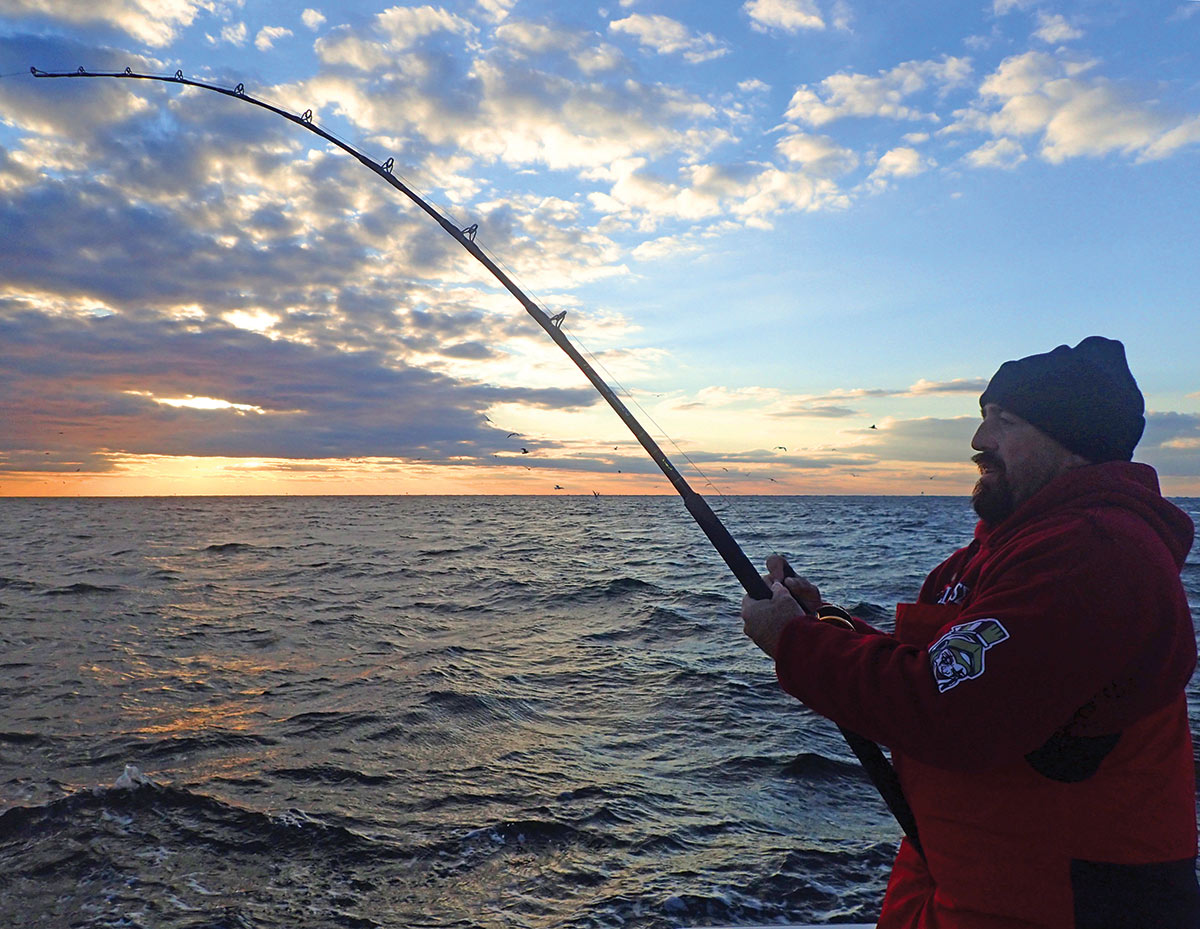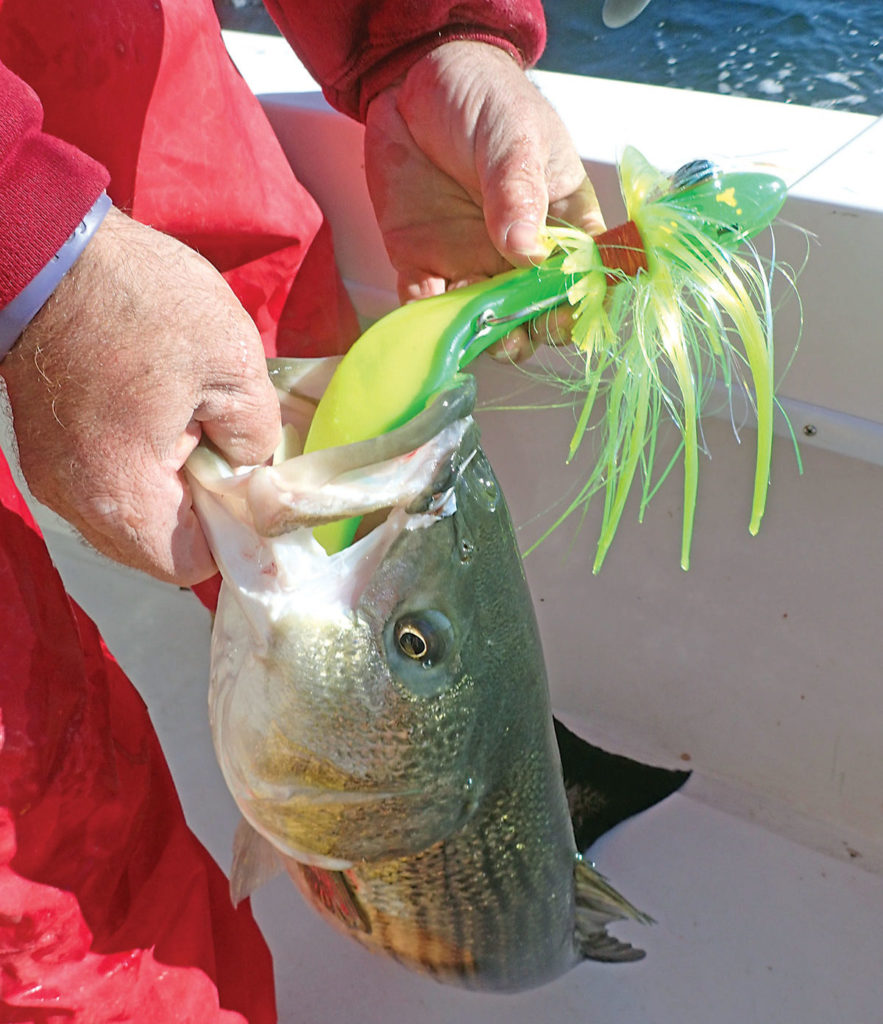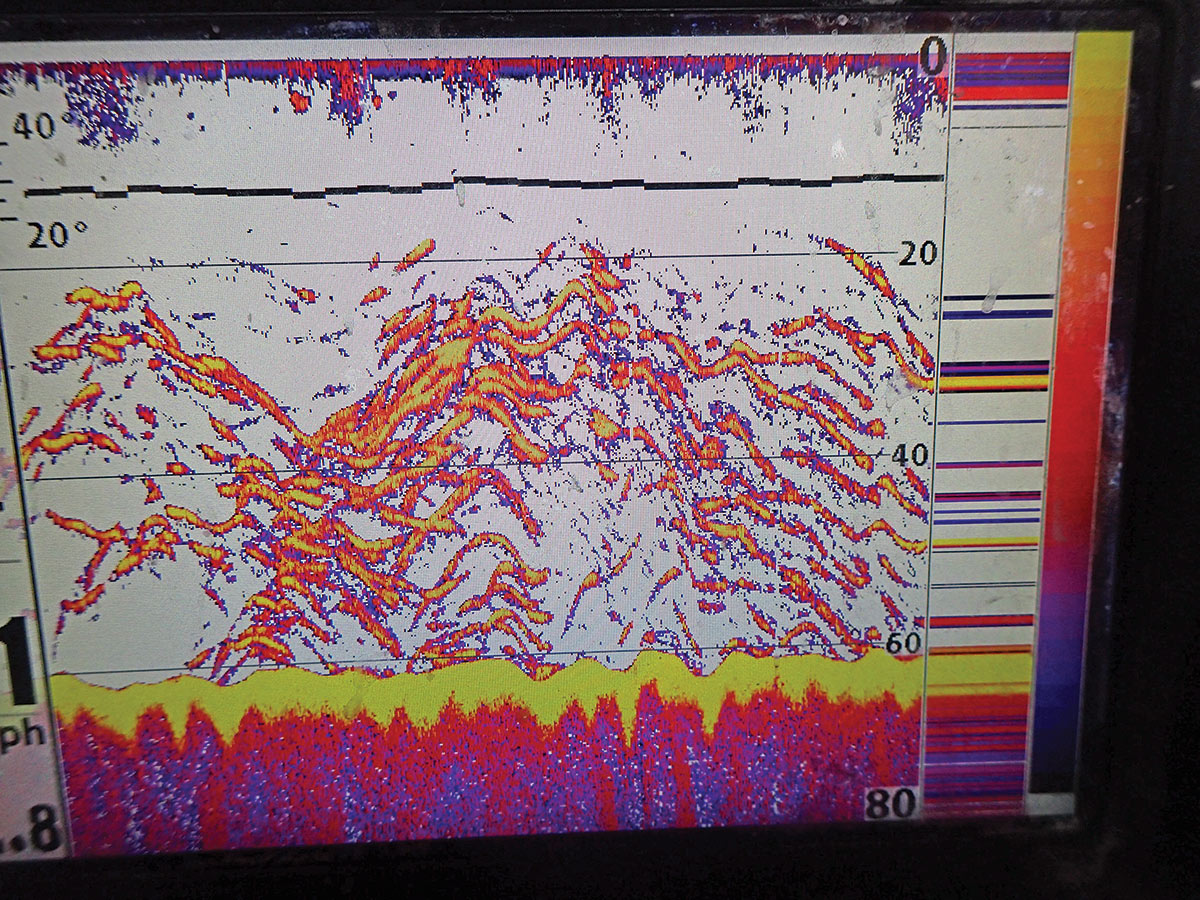
The fall run starts later and later every season, pushing the best of the South Jersey action well into the New Year!
Holiday striped bass fishing remains an event that inshore anglers look forward to each year. With the gifting mayhem in full swing and everyone trying to figure out family responsibilities, the brisk wind actually feels refreshing to anglers looking for a brief escape.
The run of bass, from dinks to large cows, is still vibrant during the last two weeks of December and can last into the New Year if ideal conditions prevail. There will still be leftover schools that pop up in North Jersey, so it’s prudent for anglers who are switching over to tautog and sea bass to keep a couple of striper outfits on the boat should they run into marks or bird plays. But in recent years, it’s been the captains with access to southern waters who find themselves in the driver’s seat at this point of the season as the stripers pass by their towns. Big bass and their little pals should proliferate December waters from Long Beach Island to Cape May and everywhere in between.
Many vessels in the Cape May charter boat fleet that were running as far as Brigantine and Atlantic City to find an early December bite for their clients won’t have to travel nearly as far because they’ll run into bass marks along the way. In turn, waters off Wildwood, Sea Isle, Ocean City and Longport will see greater amounts of fish, along with boats from as far away as Lewes, DE joining in on the holiday striped bass action.
Finding the Bite
Put to a blind choice removed from reliable, outside intelligence, it’s best for captains to start their search in the two to three mile corridor. South Jersey has a gentle, sloping, sandy decline out to sea that functions differently than that of waters north of Manasquan. The geography dictates a search grid that is often farther offshore than just outside the breakers. There, fishermen can search for large balls of bait on their sounder. In the absence of large bunker masses, anglers can search for broken clusters of bait that serve as indicators. Sometimes in the absence of forage, captains mark individual schools of bass on the fishfinder. Needless to say, fishing should commence when this takes place.
This time of year, communicating with other boats is especially important and leads to greater overall success. It’s not uncommon for a blitz or hot bite to develop nearby, and without a “call in” it’s easy to miss the action. When captains have a handful of buddies working up and down the beach, inshore and off, the odds of someone finding fish is much better. It stinks to miss the bite when it’s 10 to 20 miles away, but it’s really a bummer when it’s just a mile away!
Reliable intel is a key ingredient to captains running and gunning up and down the beaches, but it’s not much of a “call in” when a buddy waits until the 15th fish to buzz you on the cell phone. If an insane blitz develops – whether that bunker busting pops or the troll bite lights up – someone onboard needs to pay it forward and get that word over to a friend in a timely fashion. That leads to reciprocity on a different day! Constant communication is imperative, even if it’s to say the fish aren’t biting in an area. Anglers fishing with charter captains shouldn’t be annoyed by watching their skippers text away because it’s a lock that they are sharing current reports. Charter boats with a better web of report sources stand to catch more fish overall.
Choosing Tactics
Liveline techniques work well if stripers are actively feeding on the pods of densely-packed bunker. However, if many minutes or hours go by without run-offs, it’s prudent for anglers to search away from the bait. Yes, this is a complete contradiction of everything learned about bass, but it’s strangely true. Sometimes the stripers are not feeding with the bait schools that are often located closer to shore, but rather, they are migrating by in packs in deeper water. Odds are, they were feeding on those bunker at some point in their journey so it is good that they are in the neighborhood.

Fishing for bass deep and away from the main food source is when the trolling gear becomes more necessary than the snag hook. Fishermen sending bunker spoons out to the port and starboard sides and running tandem mojo rigs down the middle will have the best chance at scoring. Some captains even opt for deep diving plugs like the Rapala X-Rap Magnum, Bomber CD or Stretch 25s or 30s, as a compliment to any of the other aforementioned lures. In South Jersey, there are less snag threats than the rocky areas north of Shark River Inlet, so fishermen can set a spread deep without as much fear of losing everything to a hang.
If herring and bunker schools collide or hang in the same general vicinity, the bite can be outstanding on large fish. The bunker presence alone is enough to get the bass riled up, but herring seem to take the entire event to the next level. Anglers will run into herring snagged on their trolling gear or regurgitated up in the cooler. Many times, the stripers will create such havoc that they chase individual bunker away from the bait balls and to the surface. Boils can abound as bass crash the menhaden, sometimes gobbling it and sometimes not.
Since the water is usually in the upper 40s or a click or two above 50 degrees near the time Santa is kickstarting his sleigh, the surface action is more apt to take place any time, rather than strictly limited to the morning. Large poppers and oversized swim shads work very well, with a nod given to the subsurface swim shads for the most hook-ups. The paddletails created by companies like Tsunami and Storm are deadly effective.
Up & at ‘em

When choosing the optimal time to fish the holiday bite, dawn reigns supreme. Every day is different, but sometimes the bass push way offshore and past the three-mile line as the sun gets high. But just to keep things interesting, there are a decent of amount of days that the action takes place randomly and at any point in the day right up till sunset. Sometimes a turn of the tide can spark the action also. Anglers generally hate southwest wind, and it still isn’t the best in late December and January, but it isn’t what it is in May and June either. I’ve recorded numerous days an excellent troll bite or surface action even with the evil wind.
All through fall and especially as the water drops in temperature, anglers fish alongside whales at some point. The bass do not seem deterred by the giant mammals, and they are actually an indicator of bunker and often bass. It’s important to realize, however, that these animals can be extremely dangerous unlike gannets, gulls or cormorants that point to fish. Whale encounters with boats are becoming more and more prevalent so fishermen should use their presence as a sign, but keep their distance simultaneously. Conversely, dolphins don’t correlate with bunker or stripers in the same manner. In fact, many captains feel their presence is a negative.
Warm clothes, multiple layers, and a back up to everything from gloves to wool hats is a wise move when chasing bass late in the year. Like many, I run a center console and I use ski goggles to keep the wind off my face and my eyes from tearing up. A waterproof outer skin in the form of bibs and boots is essential. If the seas get nasty, and the fish are still biting like they often do in messy conditions, I troll with a following sea until I reach the next inlet. There, I take the calm Intracoastal Waterway back to the location from which I launched. There’s nothing like smooth water after leaving a heavy sea.
Crashing birds, desperately fleeing bunker, savage surface-feeding bass and trolling destruction are on my Christmas list this year. Good luck finding your striped bass wonderland this December.
| THE FORBIDDEN EEZ |
|---|
|
The Exclusive Economic Zone (EEZ) is basically an international term that’s used to define U.S. federal waters that extend from the three-mile line off the Atlantic Coast out to 200 nautical miles. In 1984, Federal waters were designated as off-limits for the possession and targeting of Atlantic striped bass by way of the Atlantic Striped Bass Conservation Act. In 2007, President George W. Bush designated the striped bass as a protected gamefish, directing executive agencies to use existing legal authorities to prohibit the sale of striped bass caught in federal waters in the Atlantic Ocean. In recent years, the United States Coast Guard has been actively enforcing federal regulations against both recreational and commercial fishing for striped bass in the EEZ; the fines for doing so can be substantial. |




